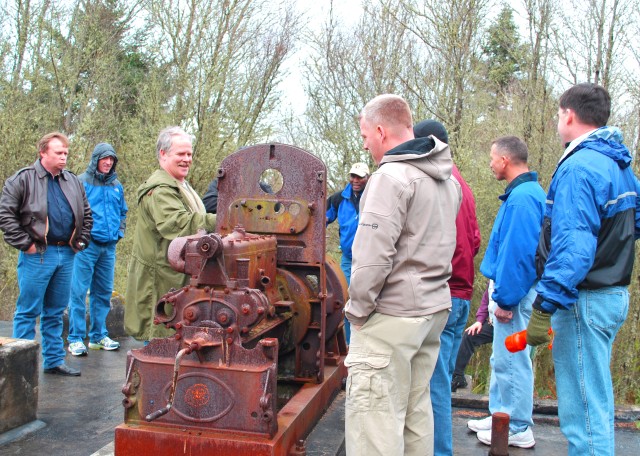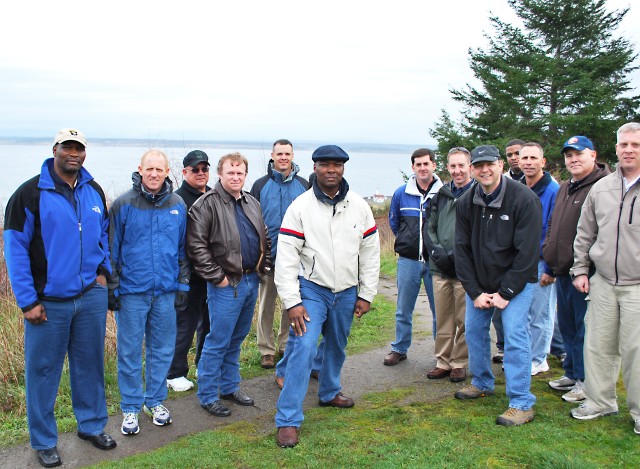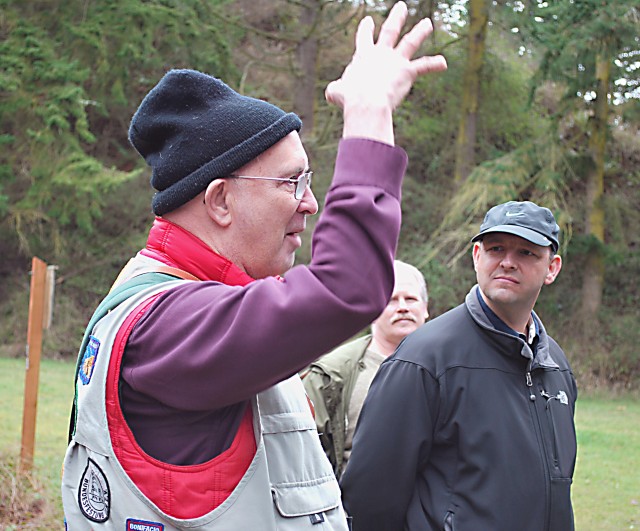FORT WORDEN, Wash. -- OK. It's a fair-enough question. "What's a Fort Worden and why isn't it pronounced as it's spelled'" Who knows, but it is "warden" as in jailer. Any local folks will affirm the pronunciation. You know, when in Rome...
Besides being the only Army installation named after a naval officer, it was the site of the first 404th Army Field Support Brigade-sponsored staff ride held in April.
Designed as part of the 404th Commanders' Workshop, the daylong event was coordinated between George Eaton, Army Sustainment Command historian, Rock Island Arsenal, and the brigade's S-3 (Operations) staff in concert with the Public Affairs and Historian offices.
The 404th AFSB is commanded by Col. George Akin.
A drippy wet, two-hour drive west of Joint Base Lewis-McChord in Tacoma, the volunteer docent from the Coastal Artillery Museum, Alfred Chiswell, met the group and began the fully narrated walk-about as the 30-knot gale and lessening showers continued to ease a bit.
Another realization. It must have taken a special Soldier to exist in the cold, dank, dark, damp, drippy, dewy, drizzly, dingy environment of the bunkers and gun pits. Respiratory illnesses were the norm, according to the expert tour guide.
Overall, Eaton noted that he was very pleased with the outcomes of the ride.
"It turned out better than I had expected because of the nature of the visit to a base and system rather than to a traditional battlefield. I know it was a lot more work than usual," he said.
"I think that Colonel Akin's and my conversation, in which we realized that this was an AMC-like "system of systems," was a flash of the obvious. But at the same time, also recognition that we can make most any history-based training relevant to the participants if we just try hard enough."
Before the "convoy'" loaded up and headed back to JBLM, each of the participants made a presentation to the group on an assigned topic dealing with "then and now" logistical issue and how they may be seen to relate to one another.
Finally, Akin presented his Commanders' Coin to Chiswell on behalf of the group, personally thanking him for all the extra time, interpretation and insight he gave for the tour.
Staff rides represent a unique and persuasive method of conveying the lessons of the past to the present-day Army leaders for current application. They bring to life examples on the very terrain where historic events took place, as applicable today as in the past. Lessons of leadership, tactics and strategy, communications, use of terrain, and, above all, the psychology of the Soldier, are nearly impossible to ignore.
Those on staff rides are rewarded with an enhanced understanding of key elements and the essential fact that battles are not systematic, logical undertakings but rather activities of men with all their frailties and strengths. Admiralty Inlet was considered so strategic to the defense of Puget Sound in the 1890s that three forts -- Worden, Flagler and Casey -- were built at the entrance.
Huge guns created a kill zone that could, theoretically, thwart any invasion attempt by sea. Fort Worden, on the Quimper Peninsula, at the extreme northeastern tip of the Olympic Peninsula, sits on a bluff near Port Townsend, anchoring the northwest side of the kill zone.
Though its guns never fired a hostile shot and were removed during World War I for use in Europe, Fort Worden was used for training a variety of military personnel and for other defense purposes. It was even used as a movie location for productions like An Officer and a Gentleman.
The three forts eventually became the first line of a fortification system known as the "Triangle of Fire" designed to prevent a hostile fleet from reaching such targets as the Puget Sound Naval Shipyard and the cities of Seattle, Tacoma and Everett. An enemy's target list would not have changed much over the years.
Construction on Fort Worden began in 1897 and continued in one form or another until the fort was closed in 1953.
Incidentally, the answer to the opening question is Cmdr. John Worden, captain of the USS Monitor, ironclad of Civil War fame and rear admiral until his death in 1897.
-30-
For queries, contact the Army Sustainment Command Public Affairs Office at rock-amsas-pa@conus.army.mil or by phone at 309-782-5421.
For current ASC news, go to www.aschq.army.mil.






Social Sharing